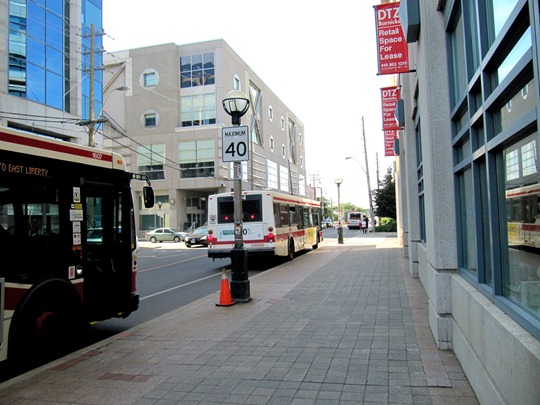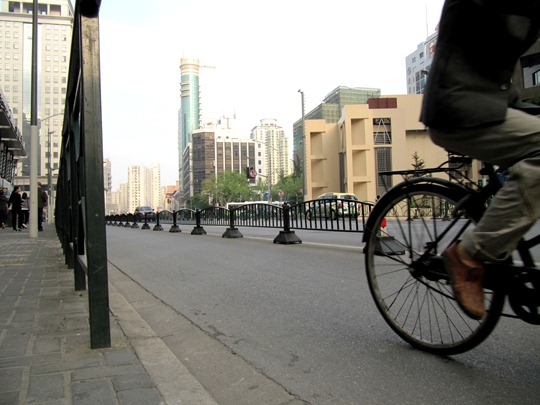Photo by James D. Schwartz / The Urban Country
In bike-unfriendly cities all over the world, politicians slap some paint down on the streets to carve out some space for bicycles so they can claim “mission accomplished” – as if painted bike lanes are the “be-all end-all” answer to urban bicycling.
Unfortunately, most of these bike lanes end up in the door zones of parked automobiles because politicians are too afraid to remove surface parking to accommodate bicycles.
It’s a shame too, because studies have shown that most shoppers on our busy shopping streets don’t arrive by automobile, so businesses have little to lose (and much to gain) by sacrificing surface parking for proper bicycle facilities.
The existence of surface parking and bad design prohibits us from implementing proper grade (or curb) separated cycle tracks.
New York City and other cities have solved this by allowing parked cars to create a barrier for physically separated bike lanes; but this requires very wide streets (often one-way) or large two-way boulevards.
Photo – New York City 9th Ave – by James D. Schwartz / The Urban Country
Sadly, slapping down paint doesn’t prevent automobiles from using bike lanes for temporary parking, taxi drop-offs/pickups or parcel deliveries. Anyone who rides a bicycle in North America will encounter these obstructions every single day – forcing bicyclists to merge on to the roadway to avoid these automobiles (or buses).
In Toronto, it’s not uncommon to have to manoeuvre around several buses parked for 5-10 minutes at a time – in a bike lane. Here you can see three buses simultaneously blocking the Strachan Ave bike lane:
Photo – Buses on Strachan Ave – by James D. Schwartz / The Urban Country
While bicycling around Shanghai, I encountered similar situations where motorists would block the bike lanes. The only difference was that painted bike lanes are very rare in Shanghai. Most bicycle tracks are physically separated, so it is uncommon to be impeded by a motorist.
Another interesting observation about Shanghai is that it is rare to see surface parking on arterial streets. Shanghai is a city of about twenty million people with about 2 million automobiles – and they do just fine without surface parking on main streets.
Here is a Shanghai bike lane on a main arterial road:
Photo “Shanghai bike lane” by James D. Schwartz / The Urban Country (2010)
In North America, one man became so frustrated with dodging cars in bike lanes that he started a website called “MyBikeLane.com”. The website allows users to upload photos of offending motorists who are blocking a bike lane. From the MyBikeLane.com website:
The website is built on the notion that:
- Cyclists are sick of having to dodge cars and trucks using the bikelane illegally.
- These illegally parked cars force cyclists into traffic, making their commute more dangerous.
- Those cyclists have cameras or cell phones w/ cameras.
- Using the power of the community, we can hopefully make the problem more obvious and get the city to do something about it.
- This makes it safer to cycle for fun or to commute.
The site shows the license plates of the top offenders for a particular city:
The mere existence of this website is a sad sign for the safety of bicyclists in North America. Preventing automobiles from impeding bicyclists is clearly not high on the priority list for the city’s bylaw officers – nor should it be. Instead, our cities should be building proper infrastructure that prevents this from happening in the first place.
While we will be waiting at least another 4 years in Toronto before we see our *first* proper on-street segregated bicycle track, we will resort to fighting for justice using the power of social networking.
James D. Schwartz is the editor of The Urban Country. You can contact James at james.schwartz@theurbancountry.com.
Related Articles:
- New York Bike Lanes Explained (Nov 2010)
- Motorists Against Bicycle Infrastructure (Oct 2010)
- Vancouver Approves Hornby Street Dedicated Bike Lanes (Oct 2010)
- Bike Lanes: A Motorist Invention? (Feb 2010)
- United States Moving Forward After Decades of Neglect (March 2010)








I agree with your points about the uselessness of paint, but I see a different solution in a more ideal world: consequences. In N. America we have some painted lanes where drivers are rarely punished for parking, little punishment for reckless driving, and shockingly little for hit-and-runs. In Japan there is little separation of cyclists and drivers (often not even of pedestrians) and their traffic death rate is about half, in much more dense traffic. The difference is that if you hit someone in Japan, you have huge liability, and the presumption is that it is the driver’s fault (unlike our presumption that the cyclist/pedestrian ‘came out of nowhere!’).
To the objection that more strict liability and better investigation is politically impossible I’d say this: stop making it a cycling issue. Make it a traffic safety issue. The fact is that the carnage for people in CARS is higher than the number of people who die of any other cause in their prime, especially for children. If we are all forced by consequences to drive safer the death rate for people in cars goes down, and incidentally for children, cyclists and pedestrians, making it safer to use the streets again.
It reminds me of what Ontario Premier Mitch Hepburn said in 1937 to a farmer who was against pasteurization:
“How many children do you have?”
“I have five,” replied the surprised farmer.
“Didn’t you have seven?”
“Yes, but two died.”
“They died of bovine tuberculosis, didn’t they? They drank milk from your own cows and died?” Hepburn persisted angrily.
“You came here today to protest against the pasteurization of milk… What kind of man are you?”
http://www.theglobeandmail.com/news/politics/second-reading/andrew-steele/guts-matter-most/article1352646/
@Mr. S. I don’t think paint is useless. The paint generally makes it much easier for me to sneak past long lineups of automobile congestion, so I think it is certainly better than no paint (I like to compare College street to King street to see that bike lanes have a real benefit in preventing me from getting squeezed into the curb). But there are of course drawbacks to just slapping down paint as I’ve pointed out.
I also agree with you that holding motorists accountable would go a long way to improving safety for everyone. It’s hard to discuss rational thoughts with irrational people though. Often, when we talk about traffic safety for everyone, the irrational lot will start ranting about bicyclists who ride on the sidewalks “endangering” pedestrians. Sorry, but people walking on sidewalks aren’t dying from bicyclists, they are dying from automobiles.
As a society, we are in denial about who causes death and carnage on our streets because drivers feel threatened. They see driving automobiles as a right, not a privilege.
The example you gave is perfect. To talk sense into these people, you just have to ask them how many people have died on our streets as a result of automobiles.
Sadly, most of them will try to blame the victims instead of accepting that the root of the problem is automobiles.
This link on people’s psychological allergy to facts that contradict their ideology is sobering: http://www.alternet.org/health/149262/are_we_too_dumb_for_democracy_the_logic_behind_self-delusion/?page=2
I know it makes me a geek, but spending time on Earth has always made me dream of being a Vulcan.
Just after you wrote this there is now a cyclist fighting for his life in hospital after being rear-ended while in a bike like on the bloor st viaduct.
Painted lines are a start, getting them out of the door-zone would be great. In urban settings that separation is key, but also better signalling for cyclists would save many lives. Intersections are where most accident happen.
Lately i’ve taken to jumping reds, when the light timing allows, it is much safer than getting caught up in the churn of tailgating drivers who don’t even see their nose they’re so close to the next guy right after the light turns green and echos what i’ve seen in other cities regarding advanced greens for cyclists.
I fully expect to be ticketed one day, but i’m tired of constantly being squeezed out.
Good points anonymous. I’m always tempted to jump the red when the way is clear so I can get away from motorists and avoid getting squeezed on streets that don’t have bike lanes.
The part that sucks about safely running reds is the $325 fine…
PS: I hope the bicyclist is ok. That’s no way to go…
Pingback: Toronto’s Fragmented Bicycle Network ← The Urban Country